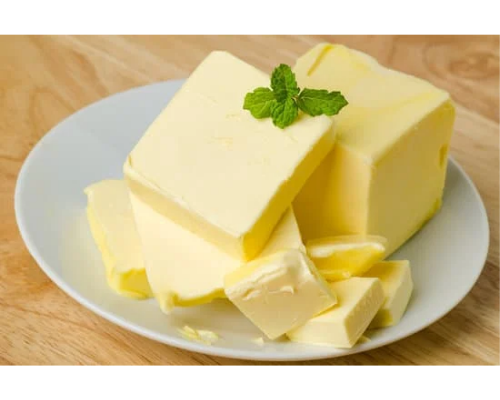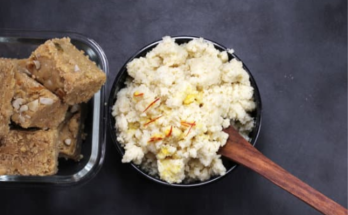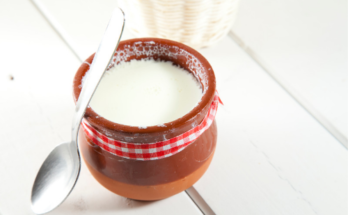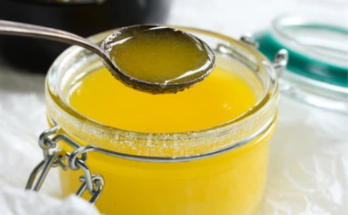Butter consists primarily of milk fat. The fat content of butter is generally about 80%. Farm butter may contain only 60 to 65% fat. The non-fat components of butter consist of moisture, milk solids, not-fat, and salt, if added.
Butter is made from sweet or sour cream. The largest percentage of butter is made from sour cream. The cream is pasteurized at 62.8°C for 30 min. or at a higher temperature for a shorter time, after which it is immediately cooled. Then, a culture of desirable microorganisms (starter) is added. The culture consists of bacteria of two types, one of which ferments lactose producing lactic acid which, in turn, curdles the milk and the other principally attacks citric acid of milk producing volatile acids and products, such as diacetyl, which give the desirable flavour and aroma of butter. The cream is then allowed to ripen at 21.1°C for several hours for the fermentation to take place.
The acidity of the curd determines the yield, quality, and storage properties of butter. When butter is made under farm conditions, cream is fermented more or less spontaneously. It is mostly prepared from dahi obtained from either self souring of unprocessed milk or by the addition of a culture, generally from the previous run.
The colour of butter varies from yellowish-white to deep yellow. The yellow colour is due to carotene, which the milking animal derives from its feed. The colour of the butter, thus, varies from season to season depending upon the nature of the feed of the animal. In order to have butter of uniform colour throughout the year, colouring material, mostly synthetic carotene, is added to the cream.
The ripened cream or dahi is next churned. Churning brings about the denaturation, by violent agitation, of the fat-globule surface, the membrane material being eliminated in butter milk. The fat globules clump together, causing a change from an oil-in-water emulsion to a water-in-oil emulsion. For this change to be effective, the temperature should be such that there is a blending of solid and liquid fat. As churning proceeds, the cream becomes granular, and a definite separation of the butter and butter milk takes place. The butter milk is drained off from the churn and the butter washed with water. Salt, if required, is added to the butter and worked sufficiently to bring butter into a compact mass. Butter is then cut to size, wrapped, and packed.





You really make iit appear really easyy along
witrh your presentation however I fond this topic
to be really one thing that I believe I’d by no means understand.
It kind of feels too complex and extremely huge
for me. I’m havbing a look frward onn your next post, I will try to get
the cling oof it! https://Evolution.Org.ua/
Thanks
I am really impressed together with your writing talents and also with the structure to your blog. Is that this a paid subject matter or did you customize it yourself? Anyway keep up the excellent quality writing, it is rare to peer a great blog like this one these days..
Howdy just wanted to give you a quick heads up and let you know a few of the pictures aren’t loading properly. I’m not sure why but I think its a linking issue. I’ve tried it in two different browsers and both show the same outcome.
But wanna remark that you have a very nice website , I enjoy the pattern it really stands out.
Thanks for the sensible critique. Me & my neighbor were just preparing to do a little research about this. We got a grab a book from our area library but I think I learned more from this post. I am very glad to see such fantastic information being shared freely out there.
Hi, i read your blog from time to time and i own a similar one and i was just wondering if you get a lot of spam comments? If so how do you prevent it, any plugin or anything you can suggest? I get so much lately it’s driving me insane so any support is very much appreciated.
Great post. I was checking continuously this blog and I’m impressed! Very helpful info particularly the remaining part 🙂 I take care of such info a lot. I was looking for this certain information for a very lengthy time. Thanks and best of luck.
Some genuinely interesting information, well written and broadly user genial.
I have learn some good stuff here. Certainly price bookmarking for revisiting. I surprise how much effort you put to make such a fantastic informative website.
I love assembling useful information , this post has got me even more info! .
Excellent read, I just passed this onto a friend who was doing some research on that. And he just bought me lunch because I found it for him smile So let me rephrase that: Thank you for lunch!
Thank you for the good writeup. It in fact was a amusement account it. Look advanced to more added agreeable from you! By the way, how can we communicate?
Good info. Lucky me I reach on your website by accident, I bookmarked it.
Hello. fantastic job. I did not imagine this. This is a great story. Thanks!
Thank you for helping out, wonderful information. “Riches cover a multitude of woes.” by Menander.
Someone essentially help to make seriously articles I would state. This is the first time I frequented your web page and thus far? I surprised with the research you made to create this particular publish incredible. Fantastic job!